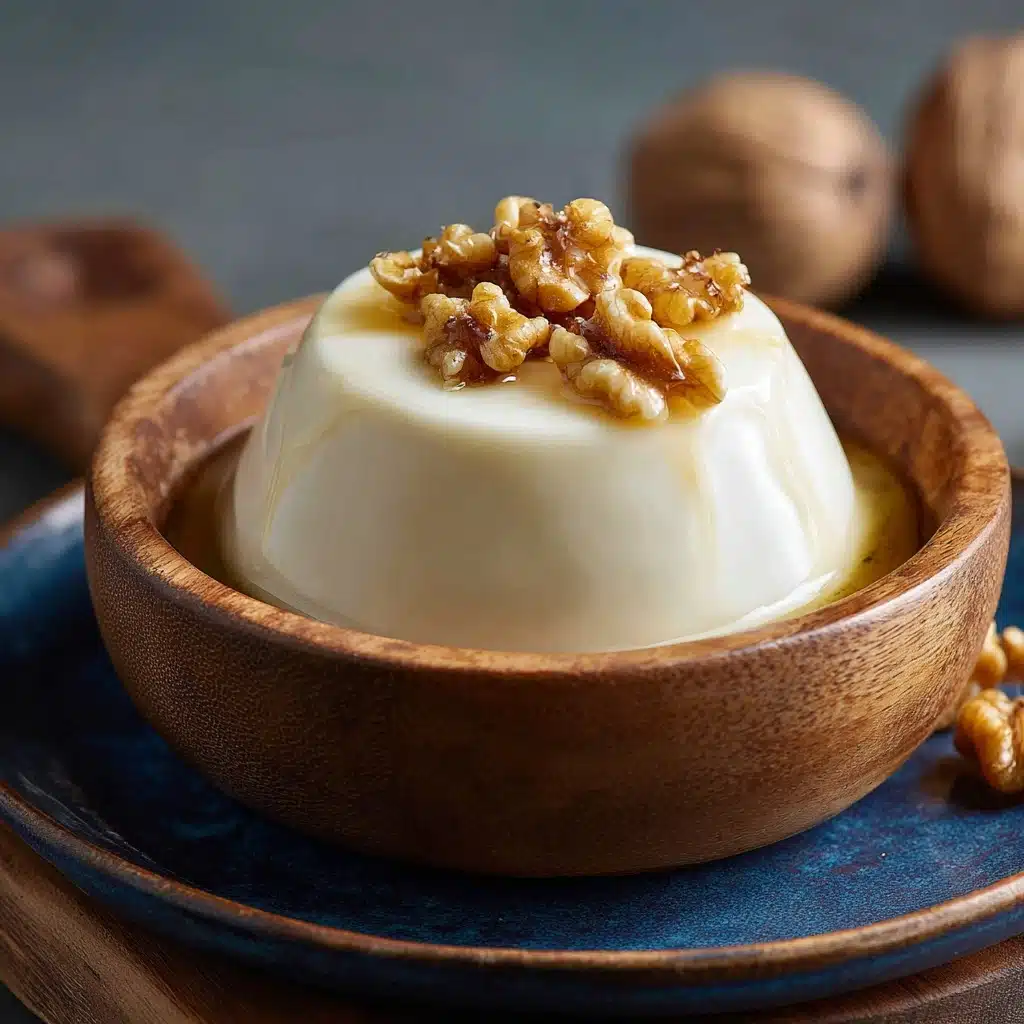There’s something almost magical about Matsoni—a gentle, silky yogurt that comes from the heart of Georgia (the country, not the state!). Making Matsoni at home is a rewarding ritual, resulting in a custard-smooth, slightly tangy yogurt that’s the stuff of breakfasts, snacks, and even desserts. It’s beautifully simple, yet feels like a deeply comforting treat; and best of all, it only takes a few kitchen staples to bring an authentic taste of Georgian tradition right to your table.

Ingredients You’ll Need
-
Ingredients:
- 4 cups whole milk (preferably non-ultra-pasteurized)
- 2 tablespoons matsoni starter culture or plain matsoni yogurt (with live active cultures)
How to Make Matsoni
Step 1: Warm the Milk Gently
Start by pouring your whole milk into a saucepan and heat it over low to medium heat. You’re aiming for a gentle warmth—about 110°F on a thermometer—just warm to the touch, not hot. This temperature wakes up the beneficial cultures, ensuring your Matsoni ferments beautifully without killing off the good bacteria.
Step 2: Prepare the Starter
If your starter yogurt has just come from the fridge, let it sit out at room temperature for 15 to 20 minutes. This takes the chill off and helps it blend more easily into the milk, creating a smooth, inviting texture right from the start.
Step 3: Combine and Mix
In a sparkling-clean glass or ceramic container (this matters—give it a good wash if needed!), add the starter and a small splash of your warmed milk. Whisk these together until smooth—no lumps hiding!—and then pour in the remaining milk, stirring until everything is well combined. This ensures an even fermentation and that every spoonful of your finished Matsoni will be delightfully thick and creamy.
Step 4: Culture the Matsoni
Cover your container loosely with a lid or a clean cloth, and let it rest in a cozy, draft-free spot—ideally around 100°F—for 12 to 24 hours. Matsoni is unique among yogurts because it thrives at slightly cooler temperatures, so you don’t need any fancy yogurt machines. Check the texture after 12 hours: you’re looking for a custard-like set and a pleasant tang.
Step 5: Chill and Enjoy
Once your Matsoni has thickened to perfection, pop it in the fridge for at least 2 hours. This cools it down, thickens it even more, and lets all those gorgeous tart flavors mellow out. Now you’re ready to dip your spoon into true homemade comfort!
How to Serve Matsoni

Garnishes
Matsoni’s subtle tang pairs effortlessly with a world of toppings. Fresh berries, a drizzle of honey, or even a handful of toasted nuts take it in a deliciously sweet direction. For a more traditional touch, try a scatter of pomegranate seeds or a few sprigs of fresh mint to brighten things up and add a splash of color.
Side Dishes
This enchanting yogurt is a breakfast staple in Georgia, often served alongside crusty bread, warm cornbread, or chewy lavash. It’s also wonderful with lightly salted cucumbers or tomatoes—perfect for a savory snack or a lively side at brunch.
Creative Ways to Present
If you want to turn Matsoni into a showstopper, try layering it with granola and fruit in individual glasses for a parfait, or swirl it into chilled soups and salad dressings for an unexpected creamy twist. Matsoni is even dreamy dolloped on top of roasted vegetables or flatbreads, adding richness without overwhelming the meal.
Make Ahead and Storage
Storing Leftovers
Keep any leftover Matsoni in a tightly sealed container in the fridge. It’ll stay fresh and delicious for up to a week—and the flavor often deepens and mellows after a day or two, making it even more irresistible as time goes on.
Freezing
While freezing isn’t the traditional route for Matsoni, you can do it in a pinch! Freeze in small portions, and let it thaw in the refrigerator. Just know that the texture may turn a little more grainy once defrosted, but it’s still wonderful for smoothies or baking.
Reheating
Matsoni is best served cold or at room temperature. If you’d like to use it warm, gently bring it up from the fridge to room temperature, avoiding direct heat so the delicate texture and live cultures stay happy and intact.
FAQs
Can I use a different type Breakfast
Absolutely! You can use 2% or even goat’s milk, though the final consistency may be a bit thinner. Whole milk really gives Matsoni that classic, lush texture, but feel free to experiment based on what you have on hand.
What if my Matsoni doesn’t thicken after 24 hours?
No need to worry—sometimes cooler room temperatures slow down the process. Try leaving it to ferment for a few more hours, or double-check that your starter had live active cultures. Next time, a slightly warmer spot (like inside an oven with the light on) can help speed things along.
How do I use Matsoni as a starter for the next batch?
Save a few tablespoons of your freshly made Matsoni before anyone digs in! That’s your starter for next time. Just use it exactly like you would the original starter yogurt, and your next batch will be just as good (if not better!).
Does Matsoni taste the same as Greek yogurt?
Not quite—Matsoni has a milder, silkier tang and a custard-soft spoon feel, unlike the thick, intense tang of Greek yogurt. It’s perfect for those who want something fresh and gentle, with a soothing flavor profile all its own.
How can I make the Matsoni thicker?
If you love your yogurt extra thick, try draining it briefly in a cheesecloth after culturing for a denser, almost dessert-like consistency. You can also use a bit less milk for every spoonful of starter, which gives a slightly firmer set.
Final Thoughts
This simple ritual of making Matsoni at home brings so much joy—not only in the eating, but in the gentle waiting and anticipation as the milk transforms. If you’re looking for a new staple that’s wholesome, flexible, and utterly delicious, Matsoni will win your heart. Give it a try and taste a little piece of Georgian comfort from your own kitchen!
Print
Matsoni Recipe
- Total Time: 10 minutes (plus 12–24 hours fermentation)
- Yield: 4 cups 1x
- Diet: Vegetarian
Description
Learn how to make matsoni, a traditional Georgian yogurt, at home with just two simple ingredients. This creamy and tangy fermented dairy treat is easy to prepare and perfect for breakfast or a snack.
Ingredients
Ingredients:
- 4 cups whole milk (preferably non-ultra-pasteurized)
- 2 tablespoons matsoni starter culture or plain matsoni yogurt (with live active cultures)
Instructions
- Heat the Milk: Heat the milk in a saucepan over low to medium heat until it reaches about 110°F, then remove from heat.
- Prepare the Starter: If using refrigerated starter yogurt, let it sit at room temperature for 15–20 minutes. In a clean glass or ceramic container, whisk the starter yogurt into a small amount of the warm milk until smooth.
- Culture the Milk: Add the rest of the milk and stir well. Cover the container loosely and let it culture in a warm spot (around 100°F) for 12–24 hours, or until thickened to a custard-like texture.
- Refrigerate: Once set, refrigerate for at least 2 hours before enjoying.
Notes
- Matsoni ferments well at slightly cooler temperatures, so room temperature in most homes is sufficient.
- Save a few tablespoons of finished matsoni to use as the starter for your next batch.
- Prep Time: 10 minutes
- Cook Time: 0 minutes
- Category: Breakfast
- Method: Fermenting
- Cuisine: Georgian
Nutrition
- Serving Size: 1/2 cup
- Calories: 80
- Sugar: 6g
- Sodium: 50mg
- Fat: 4g
- Saturated Fat: 2.5g
- Unsaturated Fat: 1.5g
- Trans Fat: 0g
- Carbohydrates: 6g
- Fiber: 0g
- Protein: 4g
- Cholesterol: 15mg







